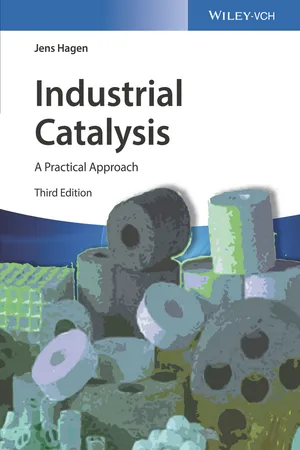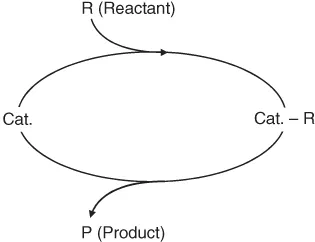
- English
- ePUB (mobile friendly)
- Available on iOS & Android
About This Book
Now in it's 3rd Edition, Industrial Catalysis offers all relevant information on catalytic processes in industry, including many recent examples. Perfectly suited for self-study, it is the ideal companion for scientists who want to get into the field or refresh existing knowledge. The updated edition covers the full range of industrial aspects, from catalyst development and testing to process examples and catalyst recycling. The book is characterized by its practical relevance, expressed by a selection of over 40 examples of catalytic processes in industry. In addition, new chapters on catalytic processes with renewable materials and polymerization catalysis have been included. Existing chaptershave beencarefully revised and supported by new subchapters, for example, on metathesis reactions, refinery processes, petrochemistry and new reactor concepts. "I found the book accesible, readable and interesting - both as a refresher and as an introduction to new topics - and a convenient first reference on current industrial catalytic practise and processes."
Excerpt from a book review for the second edition by P. C. H. Mitchell, Applied Organometallic Chemistry (2007)
Frequently asked questions
Information
Chapter 1
Introduction
1.1 The Phenomenon Catalysis

Table of contents
- Cover
- Related Titles
- Title Page
- Copyright
- Table of Contents
- Preface to the Third Edition
- Abbreviations
- Chapter 1: Introduction
- Chapter 2: Homogeneous Catalysis with Transition Metal Catalysts
- Chapter 3: Homogeneously Catalyzed Industrial Processes
- Chapter 4: Biocatalysis
- Chapter 5: Heterogeneous Catalysis: Fundamentals
- Chapter 6: Catalyst Shapes and Production of Heterogeneous Catalysts
- Chapter 7: Shape-Selective Catalysis: Zeolites
- Chapter 8: Heterogeneously Catalyzed Processes in Industry
- Chapter 9: Refinery Processes and Petrochemistry
- Chapter 10: Electrocatalytic Processes
- Chapter 11: Environmental Catalysis and Green Chemistry
- Chapter 12: Phase-Transfer Catalysis
- Chapter 13: Catalytic Processes with Renewable Materials
- Chapter 14: Polymerization Catalysis
- Chapter 15: Planning, Development, and Testing of Catalysts
- Chapter 16: Catalysis Reactors
- Chapter 17: Economic Importance of Catalysts
- Chapter 18: Future Development of Catalysis
- Solutions to the Exercises
- Index
- End User License Agreement